AstraZeneca, which is jointly developing a COVID-19 vaccine with the University of Oxford, plans to begin clinical trials testing its vaccine in combination with Russia’s Sputnik V vaccine by the end of the year.
Alexanderstock23 / Shutterstock
AstraZeneca, which is jointly developing a COVID-19 vaccine with the University of Oxford, plans to begin clinical trials testing its vaccine in combination with Russia’s Sputnik V vaccine by the end of the year. The Russian vaccine was developed by the country’s National Research Center for Epidemiology and Microbiology and the Gamaleya Center.
Earlier this week, AstraZeneca and the University of Oxford published an interim analysis of their four Phase III clinical trials of AZD1222, their COVID-19 vaccine. The data was published in The Lancet and demonstrated the vaccine is safe and effective at preventing symptomatic COVID-19. It also protects against severe disease and hospitalization.
The efficacy is 70.4%, quite a bit below that of the Pfizer-BioNTech vaccine, which began vaccinations in the UK this week and is expected to be granted Emergency Use Authorization (EUA) in the U.S. soon, and the Moderna vaccine, which will be up for EUA next week in the U.S. Both suggested efficacy of around 95%.
The AstraZeneca-Oxford data was partial results from studies in the UK, Brazil and South Africa, with safety data on 23,745 participants and protection levels on 11,636. Complicating the analysis, as reported earlier, a cohort of the trial accidentally received half-doses of the initial shot, and that group demonstrated efficacy up to 90%, which has still not been explained. The broader dosing regimen demonstrated 62% efficacy, with the average analysis demonstrating about 70%. For a vaccine, 70% efficacy is very good, but does fall well below the Pfizer-BioNTech and Moderna vaccines.
However, the data also suggests the possibility of protection after a single dose. And at least one dosing regimen appears to have decreased the number of asymptomatic infections, something which has not been evaluated in either of the other two vaccine candidates, Pfizer-BioNTech and Moderna.
In mid-November, Russia’s National Research Center for Epidemiology and Microbiology, whose Sputnik V vaccine Russia authorized for use in August—ahead of even beginning a Phase III trial—claimed it had an efficacy rate of 92% after the second dose. It was based on a first interim analysis 21 days after the first injection during the ongoing Phase III study. On November 24, the organization claimed 95% efficacy based on new preliminary data.
At this time, aside from Russia, it will potentially be sold in India, Korea, Brazil, China, and Hungary. The Hungarian government is the only European Union country to express interest to date. About 40% of the AstraZeneca-Oxford vaccine production is slotted for low- and moderate-income countries.
In a statement today, AstraZeneca reported it was evaluating how to assess combinations of different vaccines, and one of those combinations was with the Russian Sputnik V. Specifically, they are considering vaccines that use similar technology as their own, which is the case with the Sputnik V vaccine—both use common cold viruses as vectors, unlike the Pfizer-BioNTech and Moderna vaccines, which use mRNA encapsulated in nanolipid particles.
Reuters notes that the move is probably seen in Moscow as a “long-awaited vote of confidence by a Western manufacturer in Sputnik V.”
Last month, Sputnik V developers suggested on Twitter that AstraZeneca attempt the combination. AstraZeneca accepted the proposal.
“The decision by AstraZeneca to carry out clinical trials using one of two vectors of Sputnik V in order to increase its own vaccine’s efficacy is an important step towards uniting efforts in the fight against the pandemic,” said Russian Direct Investment Fund (RDIF) head Kirill Dmitriev. “We hope that other vaccine producers will follow our example.”
Kate Bingham, chair of Britain’s vaccine task force, stated earlier this week that the UK would begin trials in 2021 using vaccine combinations for the initial and booster vaccinations in hopes that a “mix-and-match” approach would maximize the immune response. It would also likely simplify dosing by allowing patients to receive one vaccine first and whatever was available second.
However, a typical problem with the approach is that the immune system might attack the adenovirus vector, neutralizing the booster shot. The adenovirus used in the AstraZeneca-Oxford vaccine is a monkey virus, while the Sputnik V adenovirus is found in humans.
Reuters also notes the partnership raises questions when the UK said in July that Russian state-backed hackers were attempting to steal COVID-19 vaccine and treatment research. The Kremlin, of course, rejected the Western allegations.





